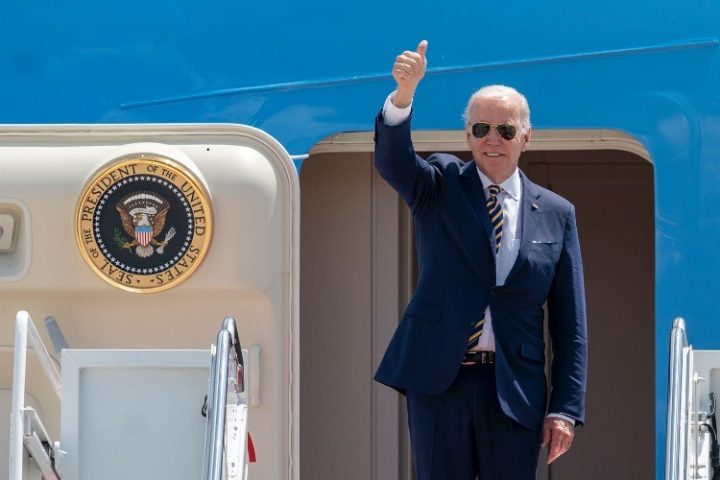
As the economy of the United States is heading into recession and Americans are struggling with staggering inflation and bracing for possible food shortages, President Joe Biden signed legislation authorizing $40 billion in military and humanitarian aid for the Volodymyr Zelensky regime of Ukraine.
The president signed H.R. 7691, aka the “Additional Ukraine Supplemental Appropriations Act, 2022,” into law on Saturday while on his first trip to Asia. According to media reports, the bill was physically flown to South Korea for Biden to sign it.
“I applaud the Congress for sending a clear bipartisan message to the world that the people of the United States stand together with the brave people of Ukraine as they defend their democracy and freedom,” Biden said in a statement on the Senate’s passing the legislation last Thursday.
The new legislation brought American support for Ukraine to nearly $54 billion, including the $13.6 billion in funding Congress enacted in March, according to a January report by the Congressional Research Service cited by USNews.com. This gargantuan number is roughly $6 billion more than the United States spent on all foreign and military aid in 2019.
Back in April, President Biden asked Congress to approve $33 billion in funding to aid Ukraine. Biden then lowered his request to $10 billion and asked Congress to include $22.5 billion more to address America’s needs in the continued fight against Covid instead. As that part of the proposal was met with opposition from many Republicans and got entangled in a politically complicated dispute over pressing immigration issues, the House decided to increase the funding to Ukraine by $7 billion on top of the original $33 billion request.
As previously reported by The New American, in total, around $24 billion of the new measure is for arming and equipping Ukrainian forces, helping them finance weapons purchases, replacing American equipment dispatched to the theater, and paying for American troops deployed in neighboring countries.
There is also nearly $9 billion to keep Ukraine’s government afloat, and the same amount to address “emerging” economic needs of the country, and half a billion to help address the country’s energy issues. Through USAID and other programs, nearly $10 billion is allocated to feed countries reliant on Ukraine’s now-diminished crop yields. In addition to that, there are funds to help settle and take care of Ukrainian refugees in the United States and Europe, and to seize Russian oligarchs’ assets.
Also on Thursday, Biden approved another package of security assistance with an additional $100 million worth of artillery, radars, and other equipment to Ukraine, making it the 10th time the president used his Presidential Drawdown Authority (PDA) to send weapons to Ukraine. That power allows him to authorize the transfer of “excess weapons” from American stockpiles without consulting with Congress first, in the case of an “emergency.”
“This brings total U.S. military assistance to Ukraine to approximately $3.9 billion in arms and equipment since Russia launched its brutal and unprovoked full-scale invasion of Ukraine on February 24,” boasted State Secretary Antony Blinken.
“Ukraine’s courageous defense forces remain firmly in the fight,” he added, “The United States, as well as more than 40 Allies and partner countries, are working around the clock to expedite shipments of arms and equipment essential to Ukraine’s defense.”
The new defense package includes such heavy artillery as 18 additional 155 mm howitzers, 18 more tactical vehicles to tow them, and three additional counter-artillery radars, Pentagon spokesman John Kirby said.
The United States has already supplied Ukraine with 90 such howitzers.
“I wonder if Americans across our country would agree if they had been shown the costs, if they had been asked to pay for it,” said Senator Rand Paul (R-Ky.), who led the opposition to the bill and was among the 11 senators who voted “no.” “We simply borrow it. ‘Put it on my tab’ is what Congress says,” he added.
Contrary to Blinken’s statement, our European allies are not as generous in supporting Ukraine.
Currently, the European allies are working to approve an additional $527 million in military aid to Ukraine, which would bring the bloc’s assistance to $2.1 billion since the conflict began.
As for the humanitarian assistance, the European Union (EU) doled out €243 million ($256.65 million) to help civilians affected by the war in Ukraine. This includes €230 million ($242.42 million) for Ukraine and €13 million ($13.73 million) for Moldova to aid people fleeing the aggression. “This EU humanitarian aid provides food, water, healthcare, shelter and helps cover people’s basic needs,” per the EU.
There is also €330 million ($348.42 million) that goes to an emergency support program “that helps to secure access to basic goods and services, such as to education, healthcare and food.”
However, European nations gave the bulk of the financial assistance in the form of loans: €9 billion ($9.5 billion) is proposed to grant “Ukraine additional macro-financial assistance in the form of loans.”
The International Monetary Fund (IMF) and Ukrainian officials estimated in April that the country needs $5 billion per month to continue paying government salaries and to cover other social expenses.
As reported by The Hill, $40 billion is likely only the beginning, and additional aid packages will be on the way.
“I’m sure there will be more to come. If the war goes on, it’s going to cost. Weapons — they use them up every day,” Senator Richard Shelby (Ala.), the senior Republican on the Appropriations Committee said, according to the outlet.




